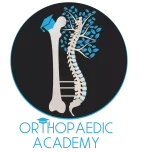Multiple Choice Questions
Trauma
Test your knowledge , learn more and get ready for your orthopaedic exam
5. A 42-year-old male who works as a professional clown presents with severe ankle pain and gross deformity after tripping and falling over his props at a children’s birthday party.
His radiograph is shown .

Following fixation of the medial and lateral malleolar fractures, the syndesmosis is assessed and is found to be persistently unstable.
All of the following are true regarding posterior malleolar fixation EXCEPT:
A) Fixation of the posterior malleolus obviates the need for syndesmotic fixation in most cases
B) Fixation of the posterior malleolus remains biomechanically inferior to trans-articular syndesmotic fixation
C) Functional and radiographic outcomes following posterior malleolar fixation are equivalent if not superior to those following syndesmotic fixation
D) Non-anatomic fixation of the posterior malleolus will compromise syndesmotic fixation
E) The syndesmosis is often incompletely injured in the setting of a posterior malleolar fracture
4. An 11-year-old boy sustains a fall while jumping on a trampoline.
He has moderate back pain, an L-5 radiculopathy, and weakness of the right extensor hallucis longus.
Radiographs and a computerized tomography scan of the lumbar spine demonstrate a slipped vertebral apophysis.
The recommended treatment is:
A) Laminectomy and excision of annulus and vertebral bony margin
B) Bed rest
C) Thoracolumbosacral orthosis
D) Physical therapy
E) Spinal traction
3. A 43-year-old construction worker sustained a work-related injury to his foot 7 months ago.
He was initially treated with cast immobilization and limited weight bearing. He has lateral foot pain and inability to walk comfortably. He has limited walking endurance.
Upon examination, pain is present laterally along the course of the peroneal tendons, and no motion of the subtalar joint is present.

The recommendation is:
A) Physical therapy followed by job modification
B) Shoe modification and orthotic support
C) Nonsteroidal medication, and ankle foot orthoses
D) Injection of the peroneal tendons with cortisone
E) Subtalar arthrodesis
2. 13y old boy injured his knee playing basketball and is now unable to bear weight.
Examination reveals tenderness and swelling at the proximal anterior tibia, with a normal neurological examination.
AP and lateral radiographs are shown .

Management should consist of:
A) MRI
B) a long leg cast
C) fasciotomy of the anterior compartment
D) open reduction and internal fixation
E) patellar advancement
1. What is the most likely complication following treatment of the humeral shaft fracture shown in the figure attached?
A) Nonunion
B) Shoulder pain
C) Infection
D) Elbow injury
E) Radial nerve injury


